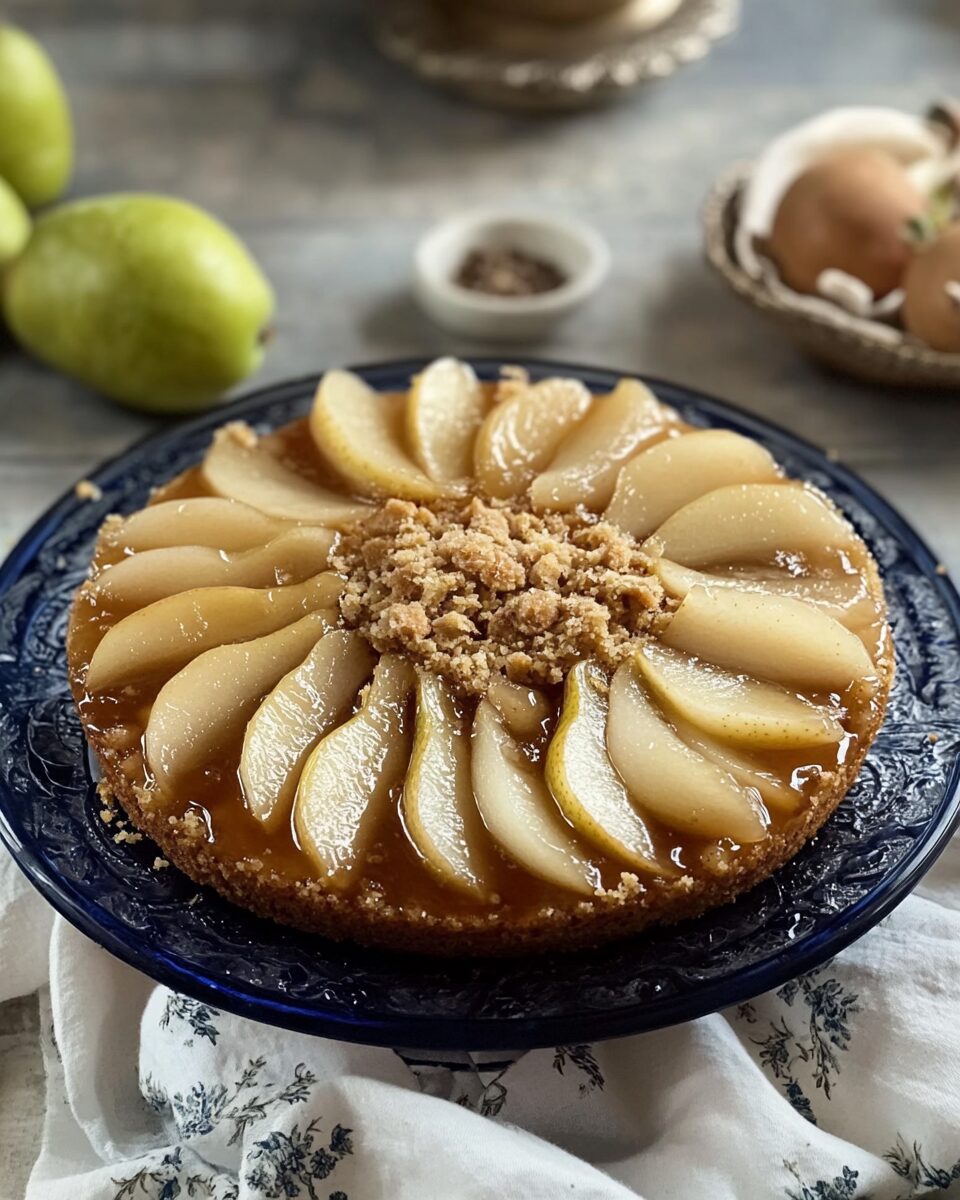The Pear Upside-Down Graham Cake is a delightful dessert that combines the natural sweetness of pears with the rich, graham-cracker-flavored base. The pears are caramelized perfectly, creating a moist and flavorful cake that is sure to be a hit for any occasion. This cake is an excellent way to use fresh pears and turn them into a decadent treat that is easy to prepare. The graham cracker crust adds a unique texture, making it a great twist on traditional upside-down cakes.
Full Recipe:
Ingredients
- 1 tablespoon butter
- 1/2 cup packed light brown sugar
- 2 medium pears, peeled, cored, and sliced
- 1 1/2 cups graham cracker crumbs
- 1/2 cup white sugar
- 1 teaspoon baking powder
- 1/2 teaspoon ground cinnamon
- 1/2 teaspoon salt
- 1 large egg
- 1/2 cup milk
- 1 teaspoon vanilla extract
Directions
- Preheat your oven to 350°F (175°C). Grease a 9-inch round cake pan with butter.
- Melt the butter in a small saucepan over medium heat. Add the brown sugar and stir until it begins to melt and combine. Pour this mixture into the bottom of the prepared cake pan.
- Arrange the pear slices over the sugar mixture in the pan.
- In a large mixing bowl, combine graham cracker crumbs, white sugar, baking powder, cinnamon, and salt. Stir in the egg, milk, and vanilla extract, mixing until smooth.
- Pour the batter over the pears in the cake pan. Spread it evenly to cover the pears.
- Bake for 30 to 35 minutes, or until the cake is golden and a toothpick inserted into the center comes out clean.
- Allow the cake to cool in the pan for 5 minutes, then run a knife around the edges. Invert the cake onto a serving plate, so the pears are on top.
- Serve warm or at room temperature.
Nutrients (per serving)
- Calories: 280
- Total Fat: 11g
- Saturated Fat: 5g
- Cholesterol: 50mg
- Sodium: 160mg
- Total Carbohydrates: 45g
- Dietary Fiber: 2g
- Sugars: 28g
- Protein: 3g
The Allure of Upside-Down Cakes
Upside-down cakes have long been a staple in baking traditions across various cultures. The concept of placing fruit at the bottom of the pan, topping it with batter, and flipping it after baking dates back to centuries ago, even before ovens were a common kitchen appliance. In earlier times, upside-down cakes were made in cast iron skillets over open fires, with fruits like apples, cherries, and pineapples. What makes these cakes so enduring in popularity is not only their visual appeal but also the way the fruit melds with the cake as it bakes, creating a moist, flavorful top layer that seeps into the batter. The Pear Upside-Down Graham Cake is a modern take on this age-old tradition, offering a contemporary twist while maintaining the same comforting qualities that make upside-down cakes so special.
Why Pears Make a Perfect Topping
Pears are often overlooked in baking, but their natural sweetness and tender texture make them an ideal fruit for upside-down cakes. When heated, pears caramelize beautifully, releasing their juices and creating a glossy, slightly syrupy layer. They hold their shape well during baking, ensuring that each slice of cake has that signature floral-like design of neatly arranged pear slices. In the Pear Upside-Down Graham Cake, the use of ripe, juicy pears balances the subtle crunchiness of the graham cracker cake base. The flavor of the pears is further enhanced when combined with a touch of brown sugar and butter during the baking process, resulting in a warm, buttery glaze that seeps into the cake and elevates every bite.
The Role of Graham Crackers in Baking
Graham crackers are more than just a snack or a base for cheesecake crusts. When crushed and used as a flour substitute in baking, they add a distinct texture and flavor that sets graham-based cakes apart. Unlike traditional sponge cakes, which rely heavily on flour, the graham cracker-based cake brings a slightly rustic, crumbly texture while still being rich and moist. In this recipe, graham crackers create a hearty base that contrasts beautifully with the smooth, syrupy pear topping. The graham flavor has a mildly nutty and honeyed undertone that enhances the overall complexity of the cake, giving it a deeper taste profile than most conventional upside-down cakes.
Texture and Flavor Profile
One of the most remarkable features of the Pear Upside-Down Graham Cake is its multilayered texture and flavor. The top layer of caramelized pears is glossy, tender, and sweet, infused with hints of butter and brown sugar. Just beneath that lies a soft, dense cake base made from crushed graham crackers, which has a slightly grainy yet melt-in-your-mouth consistency. The contrast between the juicy fruit topping and the subtly gritty cake creates a beautiful mouthfeel that is both comforting and refined. Flavor-wise, the sweetness of the pears is complemented by the mild, toasty notes of the graham cracker base, resulting in a cake that is sweet but not cloying—perfect for those who prefer balanced desserts.
Visual Presentation and Serving Appeal
The aesthetics of this cake are one of its most appealing attributes. Because the fruit is arranged at the bottom of the pan before baking, the final presentation—once the cake is inverted—reveals a stunning mosaic of pear slices atop a golden-brown cake. The natural symmetry of pear slices adds a decorative flair without any need for frosting or elaborate garnishing. The cake looks particularly impressive when served on a platter or cake stand, making it a centerpiece-worthy dessert. You can serve it warm with a scoop of vanilla ice cream, a dollop of whipped cream, or even a drizzle of caramel sauce for extra indulgence. It also holds up well when chilled, making it a versatile treat for different seasons and occasions.
Nutritional Considerations and Customization
While desserts are meant to be indulgent, the Pear Upside-Down Graham Cake offers some redeeming qualities. Pears are a good source of fiber and vitamin C, and graham crackers often contain whole grains. That said, the amount of sugar and butter in the cake does make it a treat best enjoyed in moderation.
However, this recipe can be easily customized to suit different dietary preferences or health goals. For a healthier version, you could substitute some of the butter with applesauce or yogurt, reduce the sugar content, or use low-sugar graham crackers. For a more decadent twist, some variations include adding spices like cinnamon, nutmeg, or cardamom to enhance the flavor depth. For those who are gluten-intolerant, using gluten-free graham crackers is a viable option. You could even experiment with adding a handful of chopped nuts like pecans or walnuts to the graham mixture for added crunch and nutritional value.
Cultural and Seasonal Relevance
Desserts often carry cultural significance, and the Pear Upside-Down Graham Cake is no exception. While it’s not tied to a specific tradition, its ingredients and preparation style make it a fitting addition to holiday menus, harvest festivals, and family reunions. Pears, being a fall fruit, make this cake particularly suitable for autumn and winter gatherings.
Its comforting warmth and seasonal flavor make it an ideal dessert for Thanksgiving or Christmas. At the same time, its lightness and fruitiness also allow it to fit seamlessly into spring and summer menus when served chilled or accompanied by fresh berries and cream.
Storage and Shelf Life
Another practical benefit of this cake is its excellent shelf life. The Pear Upside-Down Graham Cake stays moist for several days, thanks to the syrupy topping and the dense graham cracker base. You can store it in an airtight container at room temperature for 1-2 days, or refrigerate it for up to 5 days.
In fact, some bakers find that the flavor improves after a day, as the syrup from the pears continues to soak into the cake, enriching it further. When reheating, a quick pass in the microwave or a short bake in a preheated oven can restore its warmth and texture without compromising the flavor.
Tips for Perfect Results
While the recipe is relatively simple, there are a few tips to ensure the best results:
- Use ripe but firm pears – Overripe pears can become too mushy when baked, while unripe ones may not soften enough.
- Grease the pan thoroughly – This prevents sticking and ensures the pear topping releases cleanly when inverted.
- Cool slightly before inverting – Letting the cake rest for about 5-10 minutes after baking helps it set slightly but still allows the syrup to flow smoothly.
- Experiment with flavor add-ins – A dash of cinnamon, a pinch of salt, or a splash of vanilla extract can elevate the taste even further.
Conclusion
The Pear Upside-Down Graham Cake is a testament to how simple ingredients can come together to create something extraordinary. It’s a dessert that blends the familiar and the unexpected—a harmonious union of rustic graham cracker crumbs and the refined elegance of caramelized pears. Its charm lies in its simplicity, visual appeal, and versatility. Whether you’re a seasoned baker or a kitchen novice, this cake offers an approachable yet impressive option for your dessert repertoire. From holiday tables to casual get-togethers, it brings warmth, flavor, and beauty to every occasion.






